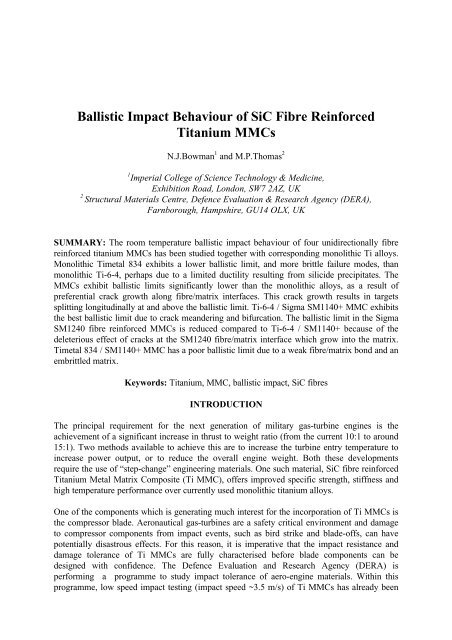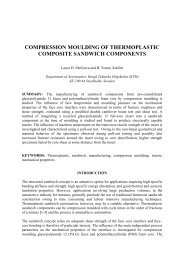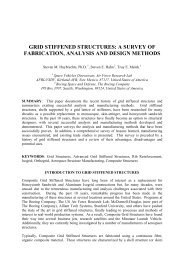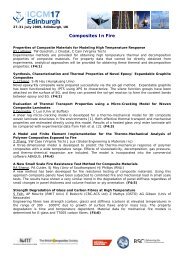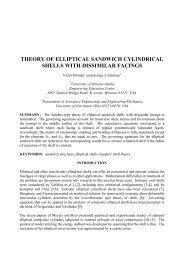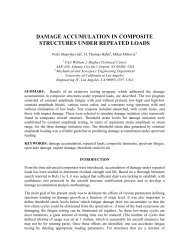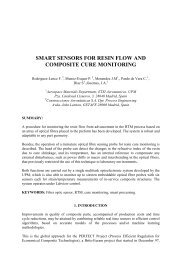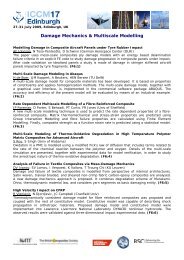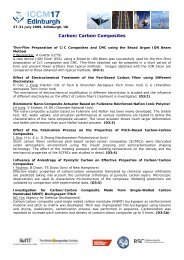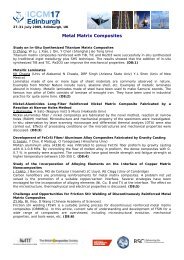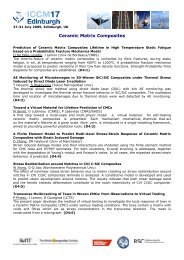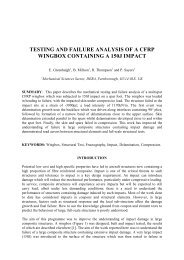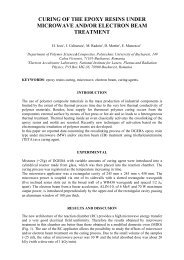Ballistic Impact Behaviour of SiC Fibre Reinforced Titanium ... - ICCM
Ballistic Impact Behaviour of SiC Fibre Reinforced Titanium ... - ICCM
Ballistic Impact Behaviour of SiC Fibre Reinforced Titanium ... - ICCM
Create successful ePaper yourself
Turn your PDF publications into a flip-book with our unique Google optimized e-Paper software.
<strong>Ballistic</strong> <strong>Impact</strong> <strong>Behaviour</strong> <strong>of</strong> <strong>SiC</strong> <strong>Fibre</strong> <strong>Reinforced</strong><br />
<strong>Titanium</strong> MMCs<br />
N.J.Bowman 1 and M.P.Thomas 2<br />
1 Imperial College <strong>of</strong> Science Technology & Medicine,<br />
Exhibition Road, London, SW7 2AZ, UK<br />
2<br />
Structural Materials Centre, Defence Evaluation & Research Agency (DERA),<br />
Farnborough, Hampshire, GU14 OLX, UK<br />
SUMMARY: The room temperature ballistic impact behaviour <strong>of</strong> four unidirectionally fibre<br />
reinforced titanium MMCs has been studied together with corresponding monolithic Ti alloys.<br />
Monolithic Timetal 834 exhibits a lower ballistic limit, and more brittle failure modes, than<br />
monolithic Ti-6-4, perhaps due to a limited ductility resulting from silicide precipitates. The<br />
MMCs exhibit ballistic limits significantly lower than the monolithic alloys, as a result <strong>of</strong><br />
preferential crack growth along fibre/matrix interfaces. This crack growth results in targets<br />
splitting longitudinally at and above the ballistic limit. Ti-6-4 / Sigma SM1140+ MMC exhibits<br />
the best ballistic limit due to crack meandering and bifurcation. The ballistic limit in the Sigma<br />
SM1240 fibre reinforced MMCs is reduced compared to Ti-6-4 / SM1140+ because <strong>of</strong> the<br />
deleterious effect <strong>of</strong> cracks at the SM1240 fibre/matrix interface which grow into the matrix.<br />
Timetal 834 / SM1140+ MMC has a poor ballistic limit due to a weak fibre/matrix bond and an<br />
embrittled matrix.<br />
Keywords: <strong>Titanium</strong>, MMC, ballistic impact, <strong>SiC</strong> fibres<br />
INTRODUCTION<br />
The principal requirement for the next generation <strong>of</strong> military gas-turbine engines is the<br />
achievement <strong>of</strong> a significant increase in thrust to weight ratio (from the current 10:1 to around<br />
15:1). Two methods available to achieve this are to increase the turbine entry temperature to<br />
increase power output, or to reduce the overall engine weight. Both these developments<br />
require the use <strong>of</strong> “step-change” engineering materials. One such material, <strong>SiC</strong> fibre reinforced<br />
<strong>Titanium</strong> Metal Matrix Composite (Ti MMC), <strong>of</strong>fers improved specific strength, stiffness and<br />
high temperature performance over currently used monolithic titanium alloys.<br />
One <strong>of</strong> the components which is generating much interest for the incorporation <strong>of</strong> Ti MMCs is<br />
the compressor blade. Aeronautical gas-turbines are a safety critical environment and damage<br />
to compressor components from impact events, such as bird strike and blade-<strong>of</strong>fs, can have<br />
potentially disastrous effects. For this reason, it is imperative that the impact resistance and<br />
damage tolerance <strong>of</strong> Ti MMCs are fully characterised before blade components can be<br />
designed with confidence. The Defence Evaluation and Research Agency (DERA) is<br />
performing a programme to study impact tolerance <strong>of</strong> aero-engine materials. Within this<br />
programme, low speed impact testing (impact speed ~3.5 m/s) <strong>of</strong> Ti MMCs has already been
carried out using Charpy testing procedures [1]. The current paper extends this work by<br />
looking at high speed impact behaviour.<br />
MATERIALS AND PROCEDURE<br />
The MMCs consist <strong>of</strong> Ti-6-4 (Ti-6Al-4V) or Timetal 834 (Ti-5.8Al-4.0Sn-3.5Zr-0.7Nb-<br />
0.5Mo-0.35Si-0.06C) reinforced with either DERA Sigma SM1140+ (carbon coated) <strong>SiC</strong> fibre<br />
or DERA Sigma SM1240 (C/TiB x coated) <strong>SiC</strong> fibre. Panels were produced by the fibre-foil<br />
route and had nominal fibre volume fractions <strong>of</strong> 0.33. <strong>Fibre</strong> reinforcement was unidirectional.<br />
The MMC microstructures have been investigated in detail elsewhere [2]. Rectangular targets,<br />
<strong>of</strong> dimensions 50mm x 50mm were machined from panels using a diamond wafering blade<br />
(target thickness was approximately 1.3mm). A few targets <strong>of</strong> monolithic Ti-6-4 and Timetal<br />
834 were also tested to act as a comparison. These were machined from plates made from<br />
alloy foils processed under the same parameters as the MMCs. Thus, they had identical<br />
microstructure to the matrices in the MMCs. Dimensions were identical to those <strong>of</strong> the MMC<br />
targets.<br />
<strong>Ballistic</strong> impact testing was carried out using the DERA low speed gas gun facility. This<br />
facility allows projectiles to be fired at speeds <strong>of</strong> between 5m/s and 300m/s, and thus simulates<br />
the impact from ingested runway debris and birdstrike [3]. The projectiles were 9.5mm<br />
diameter steel ball bearings, with a nominal weight <strong>of</strong> 3.5g. The ballistic limit has been<br />
quantified for each material, and damage development has been examined by impacting<br />
specimens at energies below the ballistic limit. Damaged and failed targets have been examined<br />
in a JEOL JSM 840a Scanning Electron Microscope (SEM) with attached wavelength<br />
dispersive X-ray spectrometer (WDX). Sections <strong>of</strong> targets were also mounted, polished and<br />
examined optically.<br />
Monolithic Ti alloys<br />
RESULTS AND DISCUSSION<br />
The results <strong>of</strong> the ballistic tests on monolithic Ti-6-4 are shown in Fig. 1. The ballistic limit was<br />
approximately 127 m/s impact velocity (28.3 J impact energy), as shown in Table 1.<br />
Fig. 1: <strong>Impact</strong> behaviour <strong>of</strong> monolithic Ti-6-4 targets
Failure was by gross cracking. This is in contrast to previous work on Ti-6-4 in which<br />
penetration <strong>of</strong> thicker targets occurs by plug formation [4,5]. The plug forms after intense<br />
localisation <strong>of</strong> plastic deformation, forming adiabatic shear bands [4-7]. Whilst adiabatic<br />
shearing still occurs in the current targets, as indicated by the shear voids on fracture surfaces<br />
(Fig. 2), this causes cracking <strong>of</strong> the targets rather than plug formation, most probably due to<br />
the use <strong>of</strong> thinner targets [8]. At impact velocities significantly above the ballistic limit, the<br />
failure mode <strong>of</strong> the monolithic Ti-6-4 begins to revert to plug formation, with less catastrophic<br />
cracking (Fig. 1).<br />
Fig. 2: Dimpling on the fracture surface <strong>of</strong> monolithic Ti-6-4 at the ballistic limit<br />
The failure behaviour <strong>of</strong> monolithic Timetal 834 is shown in Fig. 3. The ballistic limit is lower<br />
than in Ti-6-4. Although no more targets were available to test at lower impact velocities, it is<br />
apparent that the ballistic limit <strong>of</strong> Timetal 834 is equal to, or lower than, 111 m/s impact<br />
velocity (21.6 J impact energy). Target cracking appeared to be more prevalent in Timetal 834<br />
than in Ti-6-4. Testing at velocities higher than the ballistic limit resulted in Timetal 834 targets<br />
shattering into small pieces (Fig. 3), rather than reverting to plug formation as occurred in the<br />
Ti-6-4.<br />
Fig. 3: <strong>Impact</strong> behaviour <strong>of</strong> monolithic Timetal 834 targets
Fracture surfaces <strong>of</strong> Timetal 834 have a different appearance to those <strong>of</strong> Ti-6-4 (Fig. 4). The<br />
fracture surface did not appear to have been formed in shear, ductile dimples were much<br />
smaller than in Ti-6-4, and areas <strong>of</strong> cleavage failure were present. Reduced ductility and brittle<br />
failure modes have previously been observed in this foil-bonded, monolithic Timetal 834 alloy<br />
during Charpy impact tests [1] and tensile tests [9]. The failure behaviour <strong>of</strong> the Timetal 834<br />
may be linked to the presence <strong>of</strong> silicide particles in its microstructure [2]. Such particles are<br />
thought to reduce the ductility <strong>of</strong> Ti alloys [10].<br />
Fig. 4: Fracture surface <strong>of</strong> monolithic Timetal 834 at the ballistic limit, illustrating areas <strong>of</strong><br />
cleavage failure (arrowed)<br />
<strong>Titanium</strong> MMCs<br />
Although all the MMCs failed in a similar manner to each other, the damage development and<br />
failure mechanism was different to that in monolithic Ti alloys. The ball bearing causes a small<br />
area <strong>of</strong> intense deformation <strong>of</strong> both matrix and fibres through the thickness <strong>of</strong> the target,<br />
immediately below the impact point. This is observed after the test as a concave, “dished”<br />
region (Fig. 5). <strong>Fibre</strong> cracking is only observed in this dished region. Matrix cracks initiate in<br />
this dished region on the rear face and grow towards the front face, meandering to pass<br />
preferentially through the weak fibre/matrix interfaces (Fig. 6). These cracks are a result <strong>of</strong> the<br />
large anisotropy in stiffness in these unidirectionally reinforced MMCs. Previous work has<br />
shown the Young’s modulus along the fibre axis to be in the region <strong>of</strong> 200MPa [11], whilst<br />
the Young’s modulus perpendicular to the fibre axis is only around 130MPa [12]. This<br />
anisotropy means that, when impacted, the targets will flex much more in the transverse<br />
direction than in the longitudinal direction. This results in high tensile stress being generated at,<br />
and near, the rear face <strong>of</strong> targets [3], which causes the initiation <strong>of</strong> the cracks.<br />
Fig. 5: Dished region (in pr<strong>of</strong>ile) in Ti-6-4<br />
/SM1240 (all MMCs similar).<br />
Fig. 6: Crack growing from rear face <strong>of</strong> Ti-6-<br />
4 / SM1140+ (all MMCs similar)
Once the front face has been reached, these cracks then grow longitudinally along the<br />
fibre/matrix interfaces, without further fibre damage. At higher impact velocities, complete<br />
splitting <strong>of</strong> the target occurs when the failed interfaces are connected by crack propogation<br />
through the matrix. Fig. 7 shows the example <strong>of</strong> the Ti-6-4/SM1140+ MMC. Delamination<br />
between plies is not observed, because <strong>of</strong> the unidirectional nature <strong>of</strong> the reinforcement [3].<br />
Table 1: <strong>Impact</strong> results for monolithic Ti alloys and Ti MMCs at room temperature<br />
Material<br />
Ti-6-4<br />
Timetal 834<br />
Ti-6-4 / SM1140+<br />
Ti-6-4 / SM1240<br />
Timetal 834 / SM1140+<br />
Timetal 834 / SM1240<br />
<strong>Ballistic</strong> Limit<br />
<strong>Impact</strong><br />
Velocity (m/s)<br />
127.1<br />
≤ 111.3<br />
44.28<br />
41.17<br />
26.79<br />
38.21<br />
<strong>Ballistic</strong> Limit<br />
<strong>Impact</strong> Energy<br />
(J)<br />
28.3<br />
≤ 21.6<br />
3.46<br />
2.98<br />
1.27<br />
2.68<br />
Damage<br />
Meandering cracks<br />
Meandering cracks<br />
Cleaved in two<br />
Cleaved in two<br />
Cleaved in two<br />
Cleaved in two<br />
The MMCs’ ballistic limit energies are an order <strong>of</strong> magnitude lower than for the monolithic<br />
alloys (Table 1). This fact, together with the longitudinal splitting failure mode and minimal<br />
fibre fracture, shows that the anisotropy <strong>of</strong> Young’s modulus, and weak fibre/matrix interfaces,<br />
are having a deleterious effect on the ballistic impact resistance <strong>of</strong> these MMCs.<br />
Fig. 7: <strong>Impact</strong> behaviour <strong>of</strong> Ti-6-4/SM1140+ (other MMCs similar)<br />
Although the overall failure mechanism is the same for the four MMCs, their ballistic limits<br />
differ (Table 1). Ti-6-4/SM1140+ exhibits the highest ballistic limit. In this MMC, the crack
growing from the rear, tension, face frequently bifurcates (Fig. 6). This absorbs greater energy<br />
than in the case <strong>of</strong> a specimen with a single crack path. Timetal 834/SM1140+ exhibits the<br />
poorest ballistic limit. This MMC undergoes minimal crack bifurcation during growth from the<br />
rear face to the front face. It has also previously been noted that this MMC appears to contain<br />
a weaker fibre/matrix interface than the other three MMCs [12,13]. Thus, interfacial failure<br />
during longitudinal crack growth is likely to require less energy than that in the Ti-6-<br />
4/SM1140+ MMC.<br />
a. MMCs other than Timetal 834/SM1140+ b. Timetal 834/SM1140+<br />
Fig. 8: Matrix failure in the MMCs at the ballistic limit<br />
Additionally, the matrix in Timetal 834/SM1140+ MMC may contain a high carbon<br />
concentration, caused by carbon diffusion from the fibre coating when the MMC is<br />
consolidated at the high temperatures necessary for the Timetal 834 matrix. This carbon<br />
contamination appears to increase matrix embrittlement over that in the monolithic Timetal 834<br />
[11-13]. Whilst the matrix <strong>of</strong> the other three MMCs failed by ductile void growth and<br />
coalescence (Fig.8a), large areas <strong>of</strong> the matrix in the Timetal 834/SM1140+ MMC had a flat,<br />
faceted appearance indicative <strong>of</strong> cleavage cracking (Figure 8b), as was the case during Charpy<br />
impact testing [1].<br />
Fig.9: Secondary cracking in Timetal 834/<br />
SM1140+ after high velocity impact<br />
Fig.10: Interfacial cracks in SM1240 fibre<br />
reinforced MMCs, under the point <strong>of</strong> impact
Embrittlement <strong>of</strong> the matrix was further illustrated by impacting targets at a high impact<br />
velocity <strong>of</strong> 56.4 m/s (5.6 J impact energy). Whilst a Ti-6-4/SM1140+ target impacted at this<br />
speed simply cleaved in two, the Timetal 834/SM1140+ target exhibited matrix cracks<br />
perpendicular to the fibre axis, and additional longitudinal interfacial cracks (Fig.9). This<br />
combination <strong>of</strong> a brittle matrix and apparent weakness <strong>of</strong> the fibre/matrix interface could<br />
account for the poor ballistic resistance <strong>of</strong> the Timetal 834/SM1140+ MMC.<br />
The ballistic limits <strong>of</strong> the two MMCs reinforced with SM1240 fibre are similar. These two<br />
MMCs are inferior to the Ti-6-4/SM1140+ MMC because <strong>of</strong> the behaviour <strong>of</strong> the fibre/matrix<br />
interface. In Ti-6-4/SM1140+ MMC, cracks are occasionally seen in the fibre carbon coating in<br />
the dished region, but they are deflected along the carbon/TiC interface and do not grow into<br />
the matrix. By contrast, in the two MMCs reinforced with SM1240 fibres, more interfacial<br />
cracking is observed, and in these MMCs the cracks grow into the matrix (Fig.10 and black<br />
arrow in Fig.11a). Matrix failure appears to initiate at these cracks as indicated by a small step<br />
on fracture surfaces near to prior fibre/matrix interfaces (white arrows in Fig.11a). The Ti-6-<br />
4/SM1140+ MMC does not show such steps (white arrow in Fig.11b).<br />
a. Timetal 834/SM1240<br />
(Ti-6-4/SM1240 similar)<br />
b. Ti-6-4/SM1140+<br />
Fig.11: Matrix failure in the MMCs at the ballistic limit<br />
The poorer ballistic impact resistance <strong>of</strong> the Timetal 834 matrix, compared to the Ti-6-4<br />
matrix, as measured on monolithic targets, is the cause <strong>of</strong> the Timetal 834/SM1240 MMC<br />
having marginally inferior impact resistance compared to Ti-6-4/SM1240 MMC. The fact that<br />
the difference in ballistic limit <strong>of</strong> these two MMCs is relatively small indicates that the<br />
fibre/matrix interface has the dominant effect on ballistic resistance, rather than the matrix<br />
alloy.<br />
CONCLUSIONS<br />
1. Monolithic Timetal 834 has an inferior ballistic limit, and is more prone to cracking, than<br />
monolithic Ti-6-4. This may be due to the presence <strong>of</strong> silicide particles in the Timetal 834<br />
reducing the ductility.<br />
2. The ballistic impact resistance <strong>of</strong> unidirectionally reinforced Ti MMCs is significantly<br />
inferior to that <strong>of</strong> monolithic Ti alloys.<br />
3. Failure <strong>of</strong> MMC targets at the ballistic limit is caused by catastrophic longitudinal splitting at<br />
the fibre/matrix interface.
4. Timetal 834/SM1140+ has a poor ballistic limit due to a weak fibre/matrix interface and<br />
embrittled matrix.<br />
5. Cracks formed in the fibre/matrix interfacial region <strong>of</strong> SM1240 fibre reinforced MMCs<br />
grow into the matrix, having a deleterious effect on the ballistic limit.<br />
6. Ti-6-4/SM1140+ exhibits a superior ballistic limit compared to the other MMCs due to<br />
crack meandering and bifurcation, and the lack <strong>of</strong> deleterious interfacial cracking.<br />
ACKNOWLEDGEMENTS<br />
British Crown Copyright 1999/DERA. Published with the permission <strong>of</strong> the Controller <strong>of</strong> Her<br />
Britannic Majesty’s Stationery Office. N.J.Bowman is grateful for support from the Defence<br />
Engineering & Science Group (DESG) <strong>of</strong> the UK’s Ministry <strong>of</strong> Defence. Thanks are due to<br />
D.G.P.Martin for his help with the mechanical testing.<br />
REFERENCES<br />
1. M.P.THOMAS, “Charpy impact behaviour <strong>of</strong> <strong>SiC</strong> fibre reinforced titanium MMCs”,<br />
Submitted to Materials Science and Engineering, March 1999<br />
2. M.P.THOMAS, J.G.ROBERTSON and M.R.WINSTONE, “Effect <strong>of</strong> fabrication<br />
parameters on the microstructural quality <strong>of</strong> fibre-foil titanium metal matrix composite”,<br />
Journal <strong>of</strong> Materials Science, Vol.33, 1998, pp.3607 - 3614<br />
3. S.ABRATE, in “<strong>Impact</strong> on Composite Structures”, Cambridge University Press,<br />
Cambridge, 1998<br />
4. R.L.WOODWARD, “Metallographic features associated with the penetration <strong>of</strong> titanium<br />
alloy targets”, Metallurgical Transactions, Vol.10A, 1979, pp.569 - 573<br />
5. H.A.GREBE, H.R.PAK and M.A.MEYERS, “Adiabatic shear localisation in titanium and<br />
Ti-6Al-4V alloy”, Metallurgical Transactions, Vol.16A, 1985, pp.761 - 775<br />
6. Y.ME-BAR and D.SHECHTMAN, “On the adiabatic shear <strong>of</strong> Ti-6Al-4V ballistic<br />
targets”, Materials Science & Engineering, Vol.58, 1983, pp.181 - 188<br />
7. S.P.TIMOTHY and I.M.HUTCHINGS, “Initiation and growth <strong>of</strong> micr<strong>of</strong>ractures along<br />
adiabatic shear bands in Ti-6Al-4V”, Materials Science & Technology, Vol.1, 1985<br />
pp.526 - 530<br />
8. R. KINSLOW (Editor), "High velocity impact phenomena", Academic Press, 1970<br />
9. M.P.THOMAS, in “Longitudinal tensile behaviour <strong>of</strong> titanium metal matrix composites<br />
produced by the fibre-foil route”, DERA Report DRA/SMC/TR962228 (Defence<br />
Evaluation & Research Agency, Farnborough, 1997)<br />
10. A.P.WOODFIELD, M.H.LORETTO and R.E.SMALLMAN, “The influence <strong>of</strong> heat<br />
treatment on the microstructure and properties <strong>of</strong> Ti 5331S”, in “<strong>Titanium</strong>: Science and<br />
Technology”. Vol. 3. Edited by: G.Lutjering, U.Zwicker and W.Bunk (Deutsche<br />
Gesellschaft fur Metallkunde E.V., Oberursel, Germany, 1985) pp.1527 - 1534
11. M.P.THOMAS and M.R.WINSTONE, “Longitudinal yielding behaviour <strong>of</strong> <strong>SiC</strong>-fibre<br />
reinforced titanium matrix composites”, Composites Science & Technology, Vol.59, 1999,<br />
pp.297 - 303<br />
12. M.P.THOMAS and M.R.WINSTONE, “Transverse tensile behaviour <strong>of</strong> fibre reinforced<br />
titanium metal matrix composites”, Journal <strong>of</strong> Materials Science, Vol.33, 1998, pp.5499 -<br />
5508<br />
13. M.P.THOMAS and M.R.WINSTONE, “Effect <strong>of</strong> matrix alloy on longitudinal tensile<br />
behaviour <strong>of</strong> fibre reinforced titanium matrix composites”, Scripta Materialia, Vol.37,<br />
1997, pp.1855 - 1862


